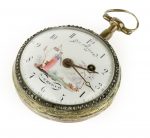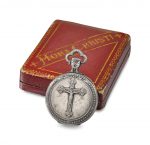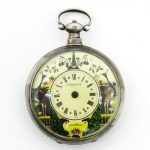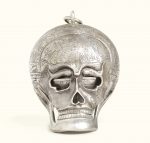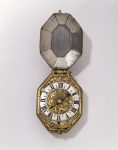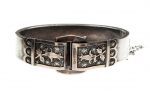A pocket watch (or pocketwatch) is a watch that is made to be carried in a pocket, as opposed to a wristwatch, which is strapped to the wrist.
They were the most common type of watch from their development in the 16th century until wristwatches became popular after World War I during which a transitional design, trench watches, were used by the military. Pocket watches generally have an attached chain to allow them to be secured to a waistcoat, lapel, or belt loop, and to prevent them from being dropped. Watches were also mounted on a short leather strap or fob, when a long chain would have been cumbersome or likely to catch on things. This fob could also provide a protective flap over their face and crystal. Women’s watches were normally of this form, with a watch fob that was more decorative than protective. Chains were frequently decorated with a silver or enamel pendant, often carrying the arms of some club or society, which by association also became known as a fob. Ostensibly practical gadgets such as a watch winding key, vesta case, or a cigar cutter also appeared on watch chains, although usually in an overly decorated style. Also common are fasteners designed to be put through a buttonhole and worn in a jacket or waistcoat, this sort being frequently associated with and named after train conductors.
An early reference to the pocket watch is in a letter in November 1462 from the Italian clockmaker Bartholomew Manfredi to the Marchese di Mantova Federico Gonzaga,[citation needed] where he offers him a “pocket clock” better than that belonging to the Duke of Modena. By the end of the 15th century, spring-driven clocks appeared in Italy, and in Germany. Peter Henlein, a master locksmith of Nuremberg, was regularly manufacturing pocket watches by 1524. Thereafter, pocket watch manufacture spread throughout the rest of Europe as the 16th century progressed. Early watches only had an hour hand, the minute hand appearing in the late 17th century. The first American pocket watches with machine made parts were manufactured by Henry Pitkin with his brother in the later 1830s. Reference: Wikipedia
A gilt key wind open face pocket watch, Rigaud, Geneva, circa 1790 The circular white dial applied with a pastoral scene to centre, black Arabic numerals, winding aperture at 2, gilt hands, gilt full plate fusee verge, pierced and engraved balance bridge, silver regulation, the case polished consular, engraved reverse, stone set bezel, numbered ‘54509’, dial and movement signed, diameter approximately 45mm
Sold for £ 137 inc. premium at Bonhams in 2018
SILVER AND TORTOISE-SHELL PAIR-CASED VERGE WATCH. . Verge escapement. Silver dial. Blued steel hand. Pair cases; plain silver inner case, outer case tortoise-shell with silver inlay decoration of birds and flowers. Producer name Made by: James Markwick biography Case made by: WF biography Date 1680-1685
Reference: © The Trustees of the British Museum
Ratel, the movement by Vacheron Constantin. A fine, rare and very unusual silver openface dual time zone keyless lever watch with special dial indicating Catholic hours of prayer and the stations of the cross, original box and literature Signed Ratel, Horloger Bte. De N. St.Pere Le Pape, movement no. 295449, case no. 177681, made circa 1893 Movement: cal. RA 18”’XX, manual, 15 jewels, numbered Dial: white enamel, gilt sun, cross and crown of thorns in the centre radiating out into 12 divisions, each sector with dedications and the stations of the cross, blued steel hands representing the instruments of the passion, gold hand indicating the time in Jerusalem, signed by Ratel Case: hinged back cast and chased with Jesus on the cross, a rosary in high relief to the edge and to the bezel, flat band with latin inscription “Vigilate Qvia Nescitis Diem Neqve Horam”, hinged silver cuvette with engraved dedication, signed by Ratel, 45.5 mm. diam. With: Vacheron Constantin Extract from the Archives confirming production of the present watch wth silver case no. 177’681 and movement no. 295’449 in 1893, original Ratel printed description and Ratel gold-tooled red morocco fitted box
Sold for CHF 18,750 at Christies in 2018
A Bovet Doplex Pocket Watch
For the Chinese market, circa 1830, hallmarked inside with Chinese silver marks, , fully decorated dial depicting peacocks, 55 mm. in diameter.
Sold for €480 at Veilinghuis de Jager in 2019
Watch Maker: Watchmaker: David Ramsay (working 1600, died 1660) Enameler: Plaques by I. R. (probably Jean Reymond) (active ca. 1615–32) of Limoges Date: ca. 1620–25
In the first quarter of the seventeenth century a small group of enamelers in Limoges produced polychrome painted enamels for watchcases. Most of the surviving enamels, including the one displayed here, were adapted from the woodcut illustrations by Bernard Salomon (1505/1510–ca. 1561) for the editions of Ovid’s Metamorphoses published in Lyon by Jean de Tournes beginning in 1555. The case of the watch was cleverly modified, probably at some time in the second half of the nineteenth century, to fit a movement of equal rarity.
Reference: The Metropolitan Museum of Art
Jacques Palliard (Paliard or Pailard) (1718-1787), Besançon, first half 18th century, A silver Memento Mori pocket watch Engraved silver skull-shaped case, exterior decoration with allegory of Death, the Birth of Eve, Adam and Eve, surrounded by foliage; interior with Nativity scene; many inscriptions in Latin: sit . justitiae satis fecit […] superavit . salutem comparavit, sicut meis sic omnibus idem, tempus ed ax rerum, tu que invidiosa vetustas, scala coeli ad gloriam via [She has satisfied justice, she has overcome trials, she has prepared salvation; as I treat my relatives, similarly I treat everyone; time devours all things; you too, old age is hungry for you; the watch, time scale is the way to the glory of the sky] Movement : gilded full plate, verge escapement, decoratively pierced with foliage motives French balance cock, spiral balance, steel counter pivot, silver set-up wheel.
Sold for 20,000 EUR at Sothebys in 2018
Octagonal watch with engraved silver and brass case, brass dial, silver chapter ring, single hand, pierced cock and pillars, verge escapement, gut-driven fusee.
The movement of this watch is engraved with the name of Robert Grinkin. There were two London watchmakers of this name, father and son. The watch appears to date from about 1610 to 1620 and may therefore be the work of Robert Grinkin senior. He is believed to have been Master of the Blacksmiths’ Company in 1609. In 1622 he was one of a group of watchmakers who asked King James I to allow them to form a company of clockmakers, aimed at keeping foreign competitors out of London. The king did not agree to their request, and it was not until 1631 that the Clockmakers’ Company was founded. Robert Grinkin senior had died in 1626, but his son went on to become Master of the Clockmakers’ Company in 1648 and 1654. The appearance of the watch suggests it was much used. The original movement was altered to prolong its useful life. The engraved decoration of the silver case, which includes scenes from the life of Jesus Christ, has been heavily rubbed by wear.
Reference: © Victoria and Albert Museum
